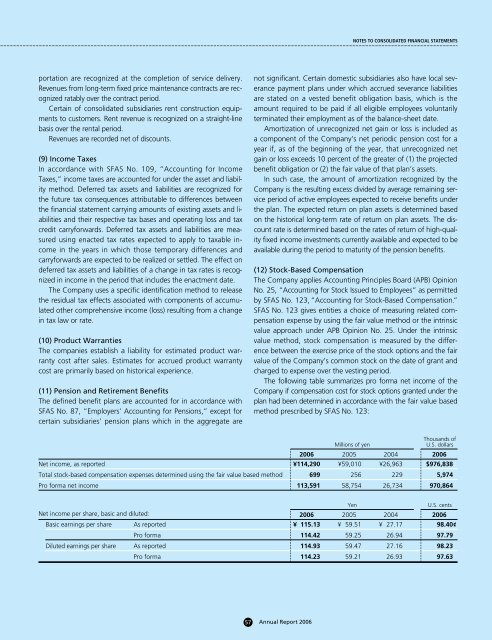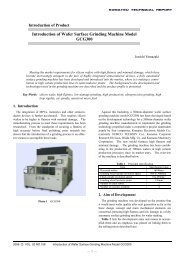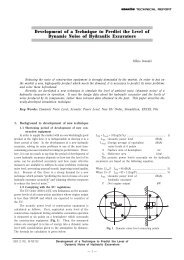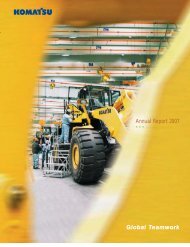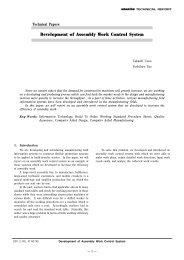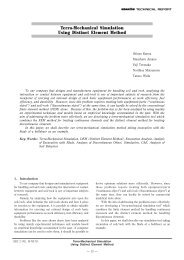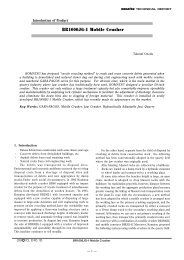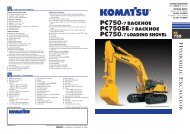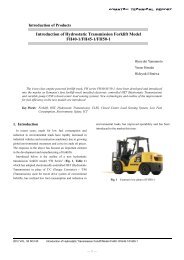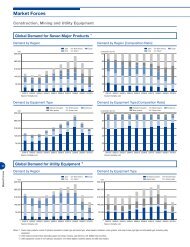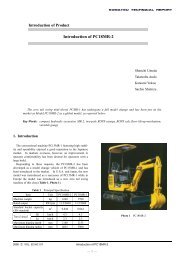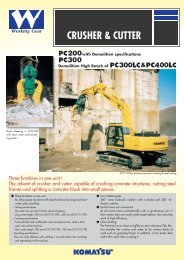Annual Report 2006 - Komatsu
Annual Report 2006 - Komatsu
Annual Report 2006 - Komatsu
Create successful ePaper yourself
Turn your PDF publications into a flip-book with our unique Google optimized e-Paper software.
NOTES TO CONSOLIDATED FINANCIAL STATEMENTS<br />
portation are recognized at the completion of service delivery.<br />
Revenues from long-term fixed price maintenance contracts are recognized<br />
ratably over the contract period.<br />
Certain of consolidated subsidiaries rent construction equipments<br />
to customers. Rent revenue is recognized on a straight-line<br />
basis over the rental period.<br />
Revenues are recorded net of discounts.<br />
(9) Income Taxes<br />
In accordance with SFAS No. 109, “Accounting for Income<br />
Taxes,” income taxes are accounted for under the asset and liability<br />
method. Deferred tax assets and liabilities are recognized for<br />
the future tax consequences attributable to differences between<br />
the financial statement carrying amounts of existing assets and liabilities<br />
and their respective tax bases and operating loss and tax<br />
credit carryforwards. Deferred tax assets and liabilities are measured<br />
using enacted tax rates expected to apply to taxable income<br />
in the years in which those temporary differences and<br />
carryforwards are expected to be realized or settled. The effect on<br />
deferred tax assets and liabilities of a change in tax rates is recognized<br />
in income in the period that includes the enactment date.<br />
The Company uses a specific identification method to release<br />
the residual tax effects associated with components of accumulated<br />
other comprehensive income (loss) resulting from a change<br />
in tax law or rate.<br />
(10) Product Warranties<br />
The companies establish a liability for estimated product warranty<br />
cost after sales. Estimates for accrued product warranty<br />
cost are primarily based on historical experience.<br />
(11) Pension and Retirement Benefits<br />
The defined benefit plans are accounted for in accordance with<br />
SFAS No. 87, “Employers’ Accounting for Pensions,” except for<br />
certain subsidiaries’ pension plans which in the aggregate are<br />
not significant. Certain domestic subsidiaries also have local severance<br />
payment plans under which accrued severance liabilities<br />
are stated on a vested benefit obligation basis, which is the<br />
amount required to be paid if all eligible employees voluntarily<br />
terminated their employment as of the balance-sheet date.<br />
Amortization of unrecognized net gain or loss is included as<br />
a component of the Company’s net periodic pension cost for a<br />
year if, as of the beginning of the year, that unrecognized net<br />
gain or loss exceeds 10 percent of the greater of (1) the projected<br />
benefit obligation or (2) the fair value of that plan’s assets.<br />
In such case, the amount of amortization recognized by the<br />
Company is the resulting excess divided by average remaining service<br />
period of active employees expected to receive benefits under<br />
the plan. The expected return on plan assets is determined based<br />
on the historical long-term rate of return on plan assets. The discount<br />
rate is determined based on the rates of return of high-quality<br />
fixed income investments currently available and expected to be<br />
available during the period to maturity of the pension benefits.<br />
(12) Stock-Based Compensation<br />
The Company applies Accounting Principles Board (APB) Opinion<br />
No. 25, “Accounting for Stock Issued to Employees” as permitted<br />
by SFAS No. 123, “Accounting for Stock-Based Compensation.”<br />
SFAS No. 123 gives entities a choice of measuring related compensation<br />
expense by using the fair value method or the intrinsic<br />
value approach under APB Opinion No. 25. Under the intrinsic<br />
value method, stock compensation is measured by the difference<br />
between the exercise price of the stock options and the fair<br />
value of the Company’s common stock on the date of grant and<br />
charged to expense over the vesting period.<br />
The following table summarizes pro forma net income of the<br />
Company if compensation cost for stock options granted under the<br />
plan had been determined in accordance with the fair value based<br />
method prescribed by SFAS No. 123:<br />
Thousands of<br />
Millions of yen<br />
U.S. dollars<br />
<strong>2006</strong> 2005 2004 <strong>2006</strong><br />
Net income, as reported ¥114,290 ¥59,010 ¥26,963 $976,838<br />
Total stock-based compensation expenses determined using the fair value based method 699 256 229 5,974<br />
Pro forma net income 113,591 58,754 26,734 970,864<br />
Yen<br />
U.S. cents<br />
Net income per share, basic and diluted: <strong>2006</strong> 2005 2004 <strong>2006</strong><br />
Basic earnings per share As reported ¥ 115.13 ¥ 59.51 ¥ 27.17 98.40¢<br />
Pro forma 114.42 59.25 26.94 97.79<br />
Diluted earnings per share As reported 114.93 59.47 27.16 98.23<br />
Pro forma 114.23 59.21 26.93 97.63<br />
57 <strong>Annual</strong> <strong>Report</strong> <strong>2006</strong>


